In 2021, the Matt Talbot Community Trust in Ballyfermot helped with the production of Jessie Buckley and Bernard Butler’s Mercury nominated album, For All Our Days that Tear the Heart. Jessie Buckley is a Killarney-born, Oscar-nominated actor and musician and the Matt Talbot Community Trust is a community education centre for people who have struggled with addiction or have been caught up in the criminal justice system or, most often, both. It’s a place that’s very important to her.
“I was in Chicago when I wrote the lyrics [to the title track] and I was having a rubbish, lonely time,” recalls the Killarney-born, Oscar-nominated actor and musician. “When I came to the record it with Bernard after we’d written it, I thought it was a protest song about being isolated, being excluded from your life and excluded from yourself, and trying to break through that pain and that struggle to be something ... I was looking for a piece for the opening, a protest, people’s voices, and I tripped across this BBC clip of a man, an alcoholic, a man in trouble, knocking on a stranger’s door and saying, ‘Will you let me in for a while, I need somebody to talk to.’ And this stranger opens the door and lets him in ... Well, it would have cost like half a thousand pounds or something [to use the clip]. So I emailed Grainne [Jennings, the manager of the Matt Talbot centre] and I said, ‘Would the Matt Talbot guys and girls say these lines for me?’ So they’re at the top of that track. That’s them saying ‘Would you let me in for a while, I need someone to talk to.’”
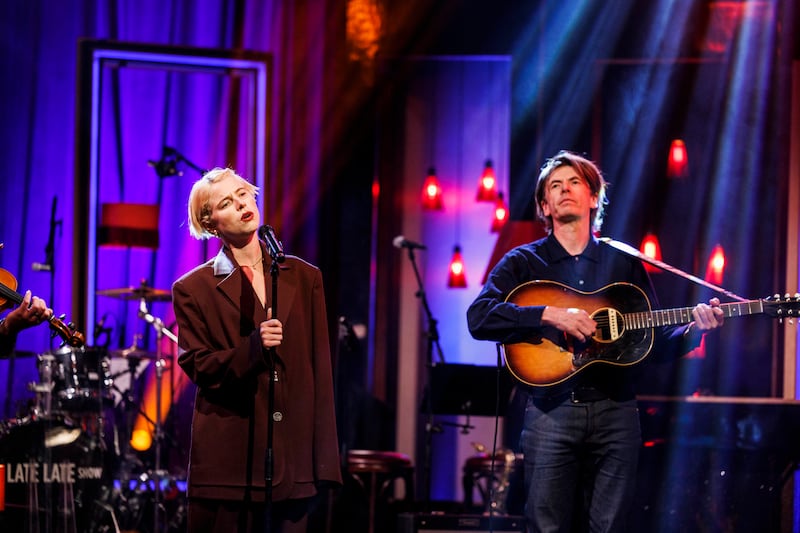
Buckley first came to public attention in the BBC’s musical-related talent show, I’d Do Anything, in 2008, when she was 17. She came second. Since then she has graduated from the Royal Academy of Dramatic Art (RADA) in the UK and gone from being a star of musicals to being one of the best actors of her generation, starring in TV shows like Fargo and Chernobyl, and films including Charlie Kaufman’s I’m Thinking of Ending Things, Alex Garland’s Men and Maggie Gyllenhaal’s The Lost Daughter, for which she received an Oscar nomination earlier this year. When we spoke last week she was en route to the Telluride film festival in Colorado for the debut of Sarah Polley’s adaptation of Miriam Toews’ novel Women Talking, in which she stars alongside Frances McDormand and Claire Foy.
It was this refuge where people who I loved could go and find solace and respite from their struggle
She doesn’t do many interviews, but she loves the Matt Talbot Community Trust. She has known it since she was a child because her late uncle was helped there and she has visited many times over the years. She was appalled when one of their main buildings was destroyed by a fire in 2018 and has played benefit concerts to help them. When she was recently asked to be involved in a Culture Night broadcast for RTÉ, she requested that it be filmed there. When I first meet her, she’s interviewing local artist Pat Curran for that broadcast. Curran is an alumnus of the Trust who has become a talented NCAD-trained artist. His work will be displayed here on Culture Night in the first new building to be built on the site.
READ MORE
Buckley explains what the place means to her: “It was this refuge where people who I loved could go and find solace and respite from their struggle. And it wasn’t just a place for the people who were struggling, it was a place for the families who were also struggling. It was an incredible community. When I was young, Sister Caoimhín who was running it was just this incredible character ... The door was always open. I’m very fond of all the people that are there ... It’s just a place where everybody who experiences struggle can go and get a bit of support and respite and feel like they belong in a world where they might not usually feel like they belong very much.”
Jennings has worked here for more than 20 years and has managed the place since the founder, Sr Caoimhín Ní Uallacháin, retired. As Buckley, Curran and the RTÉ crew film, I sit outside with Jennings as she recalls the aftermath of the fire. “I got a call early in the morning. Physically the place was just destroyed. But actually, what upset me wasn’t the physical thing ... Literally flashing in front of my eyes were the memories of the people, sitting at the dinner table, people who had subsequently passed on. I actually remember saying out loud ‘I’m never going to see that again.’”
“The Christmas dinners,” says senior project worker Karen McDonagh. “The kids coming in for Santa, the photographs going back to the 80s of various trips and activities. It was the loss of community history.”
“That was the horror of it,” says Jennings. “The people, the events — all of a sudden it felt like they had just disappeared.”
They put some portacabins on the land to work in. One of their buildings, a former priest’s house, was still standing. Since then, they’ve built the new building and have been given a new parcel of land next door by Dublin City Council. There will be a new building and gardens. McDonagh shows me the plans and points to where there will be raised beds, a sensory garden and beehives “eventually”.
He has a box for his [copper work] ‘mistakes’. He has hundreds of them, but he knows he can retrieve them and change them. And he explains that to participants, ‘No matter what happens, you have the capacity to change
The Trust itself was set up in 1986 as a drug-free refuge for men in the community who had struggled with addiction and or been incarcerated. “Sr Caoimhín would have felt that the men in a community who were out of school, often coming from prison, needed a space that they were able to retreat to,” says Jennings. “It was literally a space where people could congregate. She used to bring the guys to her home in the [nearby] convent. And she was actually given an ultimatum to stop what she was doing, or to leave, and she left.”
The original building, she says, “was built to endure a nuclear bomb ... It was dark and damp.”
“Decorated mustard from what I remember,” says McDonagh.
“It really was built like a fortress,” says Jennings. “We would have had guys coming from Mountjoy who said they believed it was probably more secure.”
Nowadays participants are all on a community employment scheme and are engaged with education and self-development. It’s no longer just for men. In reality, says Jennings, a lot of the work is about building up their self-esteem. “Even to think of yourself as being a skilled human being, that’s a hurdle that’s too far for some people to even contemplate ... I remember somebody seven times coming here, seven times leaving and saying to me, ‘Why do you keep letting me’ and I said, ‘Because you keep knocking and at some stage, it’s going to make sense to you.’ And it did, on the seventh time. That’s the journey ... For a lot of people here there’s guilt and a sense of not being able to forgive themselves.”
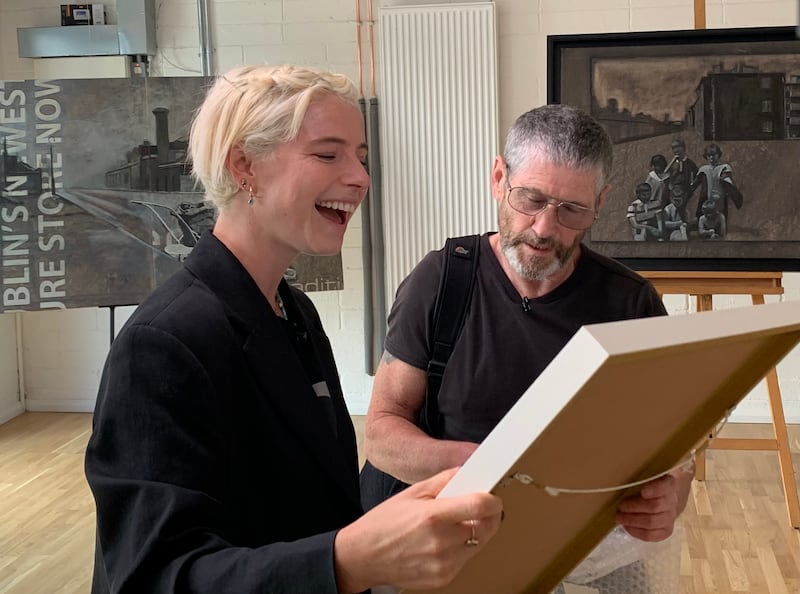
She tells me about John Farrell, a former participant now a support worker and copperwork trainer with the Trust (his work will also be displayed here on Culture Night). “He has a box for his [copper work] ‘mistakes’. He has hundreds of them, but he knows he can retrieve them and change them. And he explains that to participants, ‘No matter what happens, you have the capacity to change’.”
As we’re talking, Buckley’s mother Marina Cassidy arrives. “Hello beautiful woman,” Jennings says to her and they hug warmly. They haven’t seen each other in a while. Shortly afterwards, Buckley and Curran appear, the filming completed. Buckley is beaming. “You have got to go see his paintings,” she says to her mother. “[They’re] so unique. I can’t stop smiling. I’m so moved.”
Curran’s oil paintings are based on old photographs people in his own neighbourhood have given to him. “What’s extraordinary is I know those people,” says Buckley. “They’re our neighbours and they’re our aunties. And they’re all so distinct.”
Outside, everyone talks about a festival Buckley is playing later that night. They joke about the state of festival toilets and Jennings explains how one of the Matt Talbot participants gets his own private toilet at festivals “[He] brings a lock and an out of order sign.”
When we speak later, Buckley says of Jennings: “She’s incredible. Just look at her. She looks like Vivienne Westwood’s cousin or something. The joy. She’s so brilliant and full of life. She’s like an empathetic punk. The biggest empathetic punk you’ve ever met.”
I’m much better in other people’s lives than my own ... There are lots of ways to make art, and one is to look at your world through somebody else’s eyes
We walk into the exhibition room. Curran’s paintings are beautiful depictions of life in and around Dolphin’s Barn where he grew up. Many are drawn from old photos taken by a friend of his, Tom McLoughlin. There’s a painting of a cheeky kid mooning the camera after a swim in the canal. There are paintings of people gazing from balconies across the flat complex, or putting out their washing. There’s a painting of people picking up fallen coal from the side of the road (that one’s on a repurposed factory sign). “We were all poor,” says Curran. “We used to do that.”
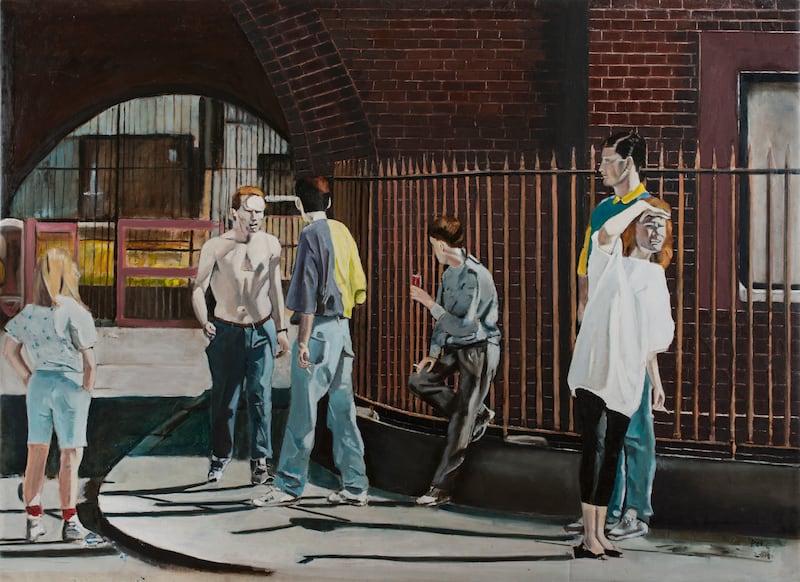
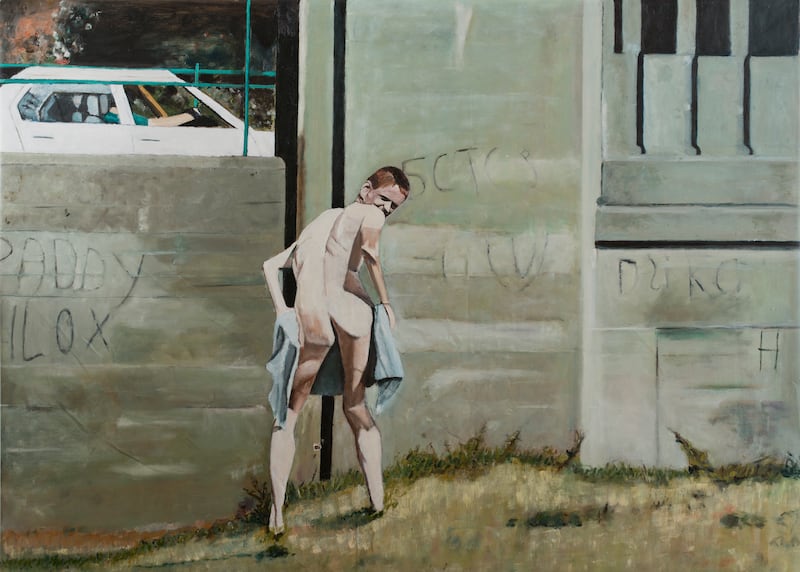
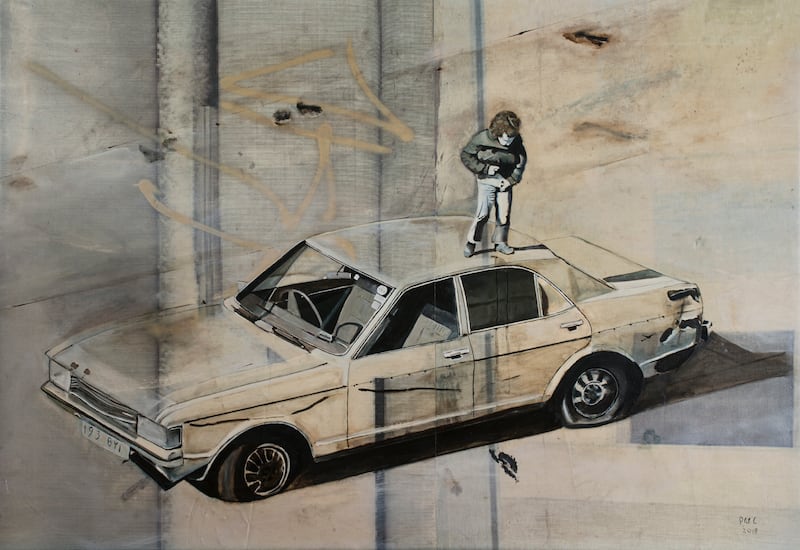
Which is his favourite? He points at one colourful picture of a group of people in which a man stripped to the waist looks like he’s challenging another man. “Maybe that one of Georgie, because it’s a painting that lies ... It looks like Georgie is going to get into a fight, but Georgie wasn’t like that. I know Georgie. He’s talking to his brother. Georgie’s a quiet individual. I’ve never heard of him being angry.”
In the exhibition space, Curran and Buckley talk together about their respective work. Later, she says: “We’re all just trying to express some things. I could have gone down many avenues if somebody hadn’t given me half a chance. I look at Pat and his work and his story and it’s so beautiful. We all have something to say, and I guess we need to be creating places where you can feel confident enough to say those things. I was blown away. I can’t paint a bloody stick ... I want to know how he made it, how he realised he could do it, what he wants to say ... It shouldn’t be privileged people who get to share their stories.”
Curran talks a little about how art allows him to become someone else. Buckley laughs when I later ask her if she can relate to that. “Oh, yeah, I definitely relate to that,” she says. “I’m much better in other people’s lives than my own ... There are lots of ways to make art, and one is to look at your world through somebody else’s eyes. That gives you a bigger heart and means you see things in the world that you didn’t know, and that’s the great privilege and joy of it ... You look at Pat’s work, and the people that he’s painting. And he’s saying ‘I see you and I’m inspired by you and I want to paint you and you’re going to look different to yourself. You’re going to look like a giant.’”
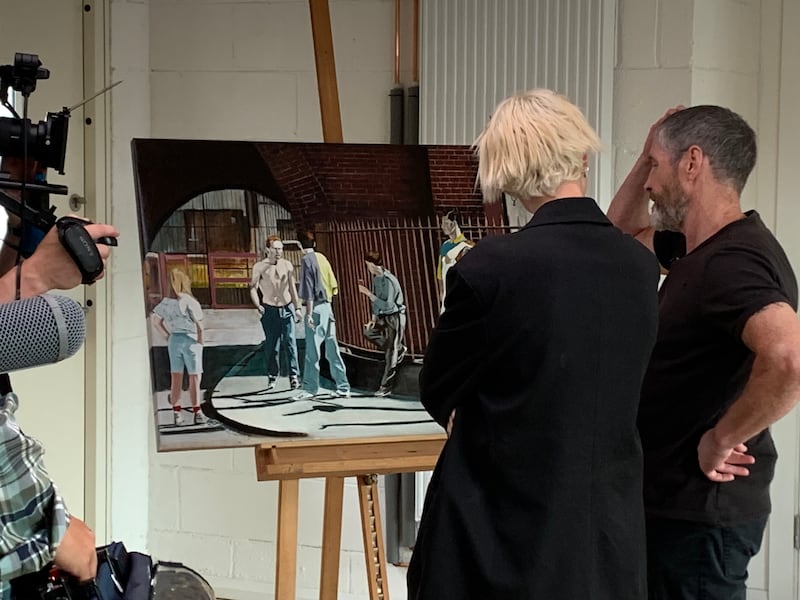
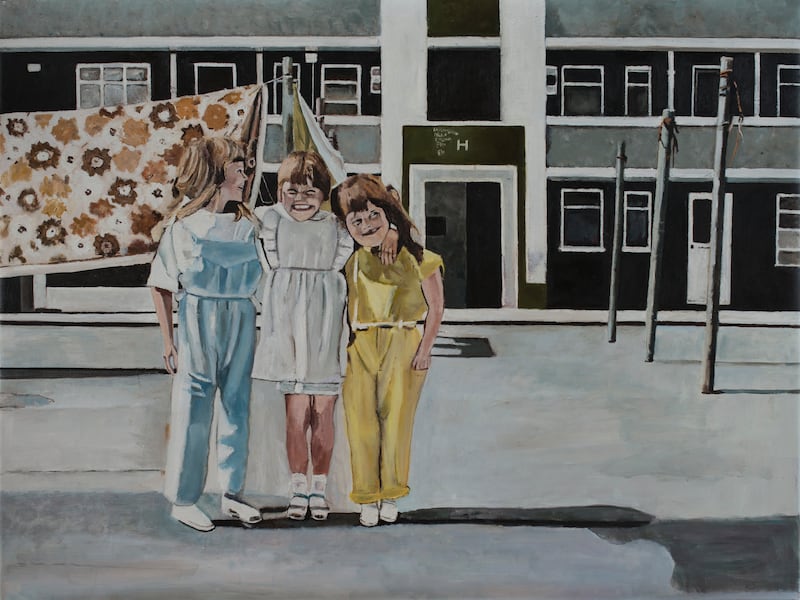
Curran never thought he’d have a degree, never mind a masters. He only started painting in his 40s, he tells me, and he’s 65 now. Did he have creative instincts before? He shakes his head. “I was subdued because of drink ... And as soon as I came off it, I started the CE scheme. Then an art teacher handed me a picture to draw, once every Wednesday.”
He pauses. “I do remember painting a picture when I was about 15 or 16 of Bob Dylan ... And as a kid I’d draw all the Marvel comics. There used to be a guy who lived up over me in Dolphin House and he was brilliant ... I used to get his drawings off him and try to imitate them.”
You don’t just learn from the people who succeed. You learn from the people who fall down and pick themselves back up
With the help of the Trust he did a portfolio course at Ballyfermot College, got on to an access programme and got into a degree course in NCAD. “I remember calling Grainne when I was three months into it saying, ‘I’m going to leave. I can’t do this. They’re asking me to do things I don’t understand.’”
He laughs. She told him: “Take a deep breath.” They encouraged and supported him. The Trust hosted his degree show and they hosted his master’s show. He wrote a thesis about Robert Rauschenberg. What appealed to him about Rauschenberg? “The move toward making art more accessible to ordinary people. Taking it away from the elitist abstract expressionists.” He laughs. “They thought they were God’s gift, the abstract expressionists.”
He loved doing his masters. “Some of the art teachers in there are like psychologists ... I remember one of them turning around and saying to me. ‘You’re able to see your culture, the things around you, clearly and a lot of people in here try to do that, but they can’t do it. You’re able to do it. And I know where you’re coming from. I’m from Finglas.” He laughs. “And I knew what I was about then.”
After my visit to the Trust, I give Buckley a call and we talk about why the place is so important to her. She hates the idea of people being written off because of their past mistakes or their poverty or their addictions. “These things could happen to any of us,” she says. “It’s being human. I’m no different to anyone in Matt Talbot. I’m probably more like them than I am [people in] the movie world ... I’m probably a bit more comfortable among them, having a cup of tea. It shouldn’t be ‘us and them’ ... You don’t just learn from the people who succeed. You learn from the people who fall down and pick themselves back up. The work that goes on there changed my whole family’s life, the kind of kindness that comes from that place. There’s no judgment. People accept each other’s struggles and hold each other’s struggles. My uncle, he was there. I wouldn’t have been the person I am today without him and without the Matt Talbot and that’s with all the hard parts as well. Life’s not some shiny box. Sometimes it’s really f**king hard.”
Does she have any memories that illustrate what the Matt Talbot Community Trust does for people? She thinks for a moment. “My uncle who was there, he was a huge presence in our lives. He was like a mythical creature. We felt so involved emotionally with him. And I remember one Christmas, he came down and he was sober at the time and he’d been with Matt Talbot for a bit. It was really helping him. And I remember, he was immaculate ... A bit like Pat, he was great with his hands and loved making clay sculptures. And he’d built the most beautiful crib out of paper mâché and other things. We still have it. I remember thinking ‘Wow, we’ve gone through lots of hard things with you, but you’ve made something so delicate and so beautiful. And this is all of you. You’re everything. There’s pain ... and you’re making really delicate fragile pieces of beauty.’ What Matt Talbot does is it gives you heart. If you can fall off the wagon you can fall on in the same extreme way and make something amazing of yourself.”
Pat Curran’s work will be exhibited at the Matt Talbot Community Trust between 4 and 7.30pm on Culture Night, Friday September 23rd. Jessie Buckley’s interview with Pat Curran will air as part of Culture Night: Live at Lough Boora, on the same night on RTÉ 1 at 7pm.















